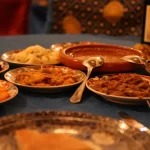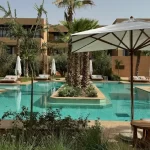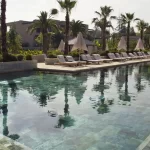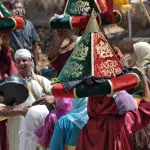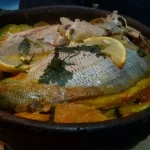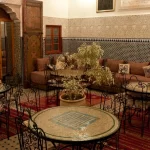Exploring the Desert Village of M’Hamid El Ghizlane | Ultimate Guide
Salmane Bougzime
September 24, 2025
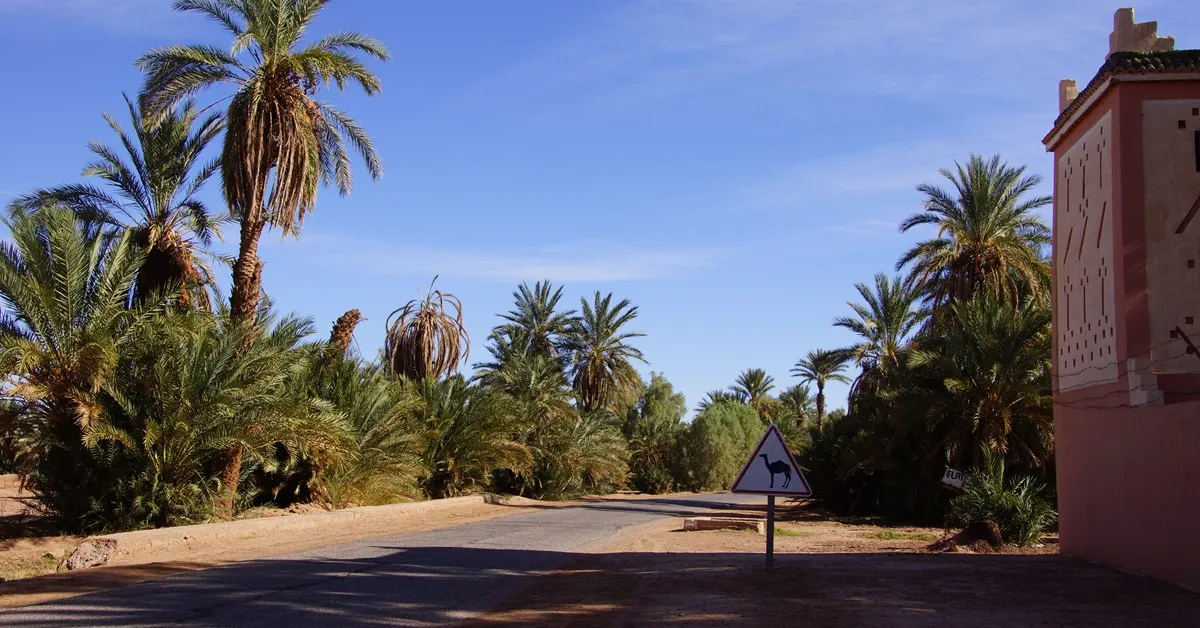
When you arrive at M’Hamid, Morocco’s last desert outpost before the great Sahara, you’ll find yourself at the edge of two worlds.
Ancient mud-brick buildings rise from golden sands while traditionally robed locals navigate narrow streets that haven’t changed in centuries.
This remote village, positioned where the paved road ends and endless dunes begin, serves as your gateway into a realm where Berber culture meets essential survival skills beneath the desert sun.
Key Takeaways
- M’Hamid sits at Morocco’s Sahara Desert edge, serving as a gateway for desert tourism and historically connecting trade routes to Timbuktu.
- Ancient mud-brick ksars with defensive towers showcase traditional architecture while the preservation efforts maintain these historical buildings.
- Visitors can explore nearby Erg Chegaga’s 60-meter dunes through guided tours, with optimal travel between October and April.
- The annual Festival Taragalte celebrates nomadic culture through music, artisan workshops, and desert conservation education.
- The village blends traditional lifestyles with modern adaptations, featuring weekly souks and water conservation practices amid desert challenges.
The Last Oasis Before the Sahara

Nestled at the edge of Morocco’s vast Sahara Desert, the remote village of M’Hamid stands as the final outpost of civilization before the endless sea of sand begins.
You’ll find this remarkable settlement perched 500 meters above sea level, where the delicate oasis ecology supports life in an otherwise harsh landscape.
At coordinates 29°49′20″N, 5°43′15″W, M’Hamid’s strategic location along the Algerian border makes it a crucial gateway for sustainable tourism ventures into the Sahara.
In its heyday, the oasis served as a vital stopover for trade caravans to Timbuktu.
Positioned at nature’s threshold between nations, M’Hamid serves as the sustainable launching point for authentic Saharan exploration.
From here, you’re just 50 kilometers from the towering dunes of Erg Chigaga, where the real desert adventure begins.
The village’s position as the last inhabited area before the great sand sea has shaped its role as a vital rest stop, where travelers can prepare for their journey into one of Earth’s most challenging environments.
A Rich History of Desert Trade Routes

At Sidi Khalil, you’d have witnessed massive camel caravans of up to 5,000 animals assembling before their arduous journey to Timbuktu, a trek that would take 52 days to complete.
Today, the area known as the Bounou region remains home to the traditional tribes that once controlled these historic routes.
The trade dynamics here were complex, with Berber, Drawa, and Hassani tribes controlling access to vital corridors that connected Mediterranean markets to sub-Saharan Africa.
You’ll find evidence of this rich commercial heritage in the weekly souk markets that still operate today, though the historic trade routes began declining in the 1970s when drought and disease devastated the region’s agricultural foundation.
Three major caravan routes once converged at M’Hamid, establishing it as one of North Africa’s most crucial desert trading posts for over five centuries.
Discovering Ancient Ksars and Architecture

Several ancient ksars dot M’Hamid’s stark desert landscape, their towering mud-brick walls and defensive towers standing as a testament to centuries of architectural innovation.
You’ll find these fortified structures built with remarkable ingenuity, using traditional techniques like rammed earth (pisé) and local materials that have withstood harsh desert conditions for generations.
As you explore these architectural marvels, you’ll notice the thick defensive walls and strategic corner towers that once protected desert communities from invaders.
Today, ksar preservation faces significant challenges from both environmental and social factors, but organizations like Terrachidia are working to maintain these historic structures.
They’re teaching traditional building methods like tadelakt waterproofing and mud-brick construction to ensure these ancient architectural techniques aren’t lost to time.
The region’s Marabout of Sidi Abdellah serves as an important cultural and architectural landmark within the oasis community.
The Vibrant Festival Taragalte

When you visit M’Hamid during the annual Festival Taragalte, you’ll discover traditional desert music performances under starlit skies while surrounded by towering Saharan dunes.
The festival serves as a vibrant celebration of nomadic heritage, bringing together artists, musicians, and craftspeople who showcase everything from traditional weaving to contemporary fusion performances.
Founded by brothers Brahim and Halim Sbai, the festival has grown into a major cultural event that draws thousands of visitors each year.
Through carefully planned sustainability initiatives and educational programs about desert conservation, the festival demonstrates how cultural celebrations can promote environmental awareness while preserving ancient traditions for future generations.
Desert Music Under Stars
Against the backdrop of Morocco’s vast desert expanse, the Festival Taragalte transforms M’Hamid El Ghizlane into a mesmerizing celebration of music and cultural heritage.
As night falls, desert rhythms emerge from camouflaged tents, where local musicians blend traditional Tuareg sounds with contemporary nomadic harmonies.
You’ll experience performances under pin-bright starfields, where the silence of the Sahara provides a natural amphitheater for cross-cultural collaborations.
International artists join local youth, creating unique fusions that bridge ancient Mali formalism with modern desert blues.
During lunar eclipses, the music takes on an ethereal quality, with Jonathan Day’s fiddle complementing Ensemble Bilali Soudan’s traditional arrangements.
These musical gatherings serve a deeper purpose, supporting local initiatives for cultural preservation while combating desertification through community-driven environmental projects.
Cultural Heritage Celebration

Through its vibrant celebration of nomadic heritage, the Festival Taragalte stands as M’Hamid’s premier cultural event since its founding in 2009.
You’ll discover authentic cultural expressions through artisan workshops featuring traditional pottery, weaving, and jewelry-making using materials like camel hair and desert minerals.
At the festival’s core, heritage preservation comes alive as you experience the ancient moussem traditions, where local guides share historical narratives of trans-Saharan caravan culture.
You can taste authentic sand bread baked using nomadic methods, sip traditional sugary tea, and browse markets filled with regional desert spices.
The celebration seamlessly blends Amazigh and Arab influences, creating a dynamic platform where traditional craftsmanship meets modern tourism, ensuring these time-honored practices continue to thrive in M’Hamid’s evolving landscape.
Environmental Awareness Showcase
The Festival Taragalte’s environmental awareness initiatives serve as a powerful platform for desert conservation education and action.
Through hands-on workshops and collaborative sessions, you’ll discover sustainable practices that local communities have developed to protect their fragile desert ecosystem.
You’ll find informative displays highlighting ecological initiatives focused on water management and anti-desertification efforts, while expert-led presentations demonstrate how traditional nomadic knowledge continues to shape modern conservation strategies.
The festival’s environmental programming seamlessly integrates cultural heritage with practical solutions, allowing you to participate in sessions about desert-friendly agriculture and water preservation techniques.
These educational components are further enhanced by partnerships with eco-tourism organizations that help fund ongoing conservation projects throughout the M’Hamid region.
Modern Challenges in a Changing Landscape

Modern life in M’Hamid unfolds against a backdrop of unprecedented environmental and societal upheaval, where once-fertile oasis landscapes now face aggressive desertification.
You’ll witness the stark reality of migration challenges as younger generations abandon traditional ksars for urban opportunities, leaving behind centuries-old earthen villages to crumble against advancing sand dunes.
The environmental adaptation has become increasingly urgent, with the oasis losing two-thirds of its surface area in just four decades.
As you explore the region, you’ll observe how the prolonged drought since 2014 has transformed the agricultural landscape, where thriving date palm groves have given way to barren terrain.
Local families now struggle to maintain their farming traditions as water tables continue to drop, forcing a dramatic shift toward tourism-based livelihoods.
Life in a Traditional Moroccan Desert Town

In M’Hamid, you’ll witness daily life unfold against a backdrop of traditional adobe buildings and newer concrete structures painted the region’s signature bright red.
The town’s architectural evolution reflects both practicality and preservation, as residents maintain centuries-old kasbahs while adapting to modern needs in a harsh desert environment that requires constant building maintenance against encroaching sand.
Despite significant changes to the local economy and lifestyle, M’Hamid’s cultural heritage remains vibrant through its weekly Monday souks, annual Festival Taragalte celebrations, and continuing tradition of desert navigation and hospitality.
Daily Desert Village Life

Nestled within Morocco’s southeastern desert expanse, M’Hamid’s daily village life presents a fascinating blend of traditional rhythms and modern adaptations that you’ll encounter throughout its compact, walkable streets.
You’ll see residents navigating narrow paths on small motorbikes while donkey carts transport goods to the Monday market, where local cuisine features fresh vegetables brought in by camel from distant regions.
Water shapes the community’s daily routine, as you’ll notice taps running dry by early afternoon, prompting careful conservation practices that contrast sharply with tourist facilities.
While French serves as the common language for visitor interactions, you’ll experience the village’s rich cultural heritage through community festivals and storytelling traditions, all while witnessing how modern desert tourism coexists with age-old Sahraoui customs.
Traditional Architecture Meets Modernity
While traditional mud-brick buildings stand as testaments to M’Hamid’s architectural heritage, you’ll find an evolving blend of old and new construction methods throughout the desert town’s winding streets.
Today, you’ll see heritage restoration projects incorporating sustainable techniques that combine laboratory-tested earth finishes with local stabilizers, ensuring buildings can withstand harsh desert conditions.
As you explore the town’s fifteen restored historic structures, including ancient fortified gates and mosques, you’ll notice how modern amenities have been thoughtfully integrated without compromising traditional aesthetics.
You can participate in hands-on workshops where local craftsmen demonstrate time-honored building methods, while Spanish university collaborations have introduced innovative preservation approaches that enhance the durability of traditional materials like earth, wood, and lime.
Cultural Heritage Still Thrives
Beyond the architectural landscape, M’Hamid’s vibrant cultural heritage pulses through every corner of daily life.
You’ll witness traditional cultural practices seamlessly woven into the community’s fabric, from women crafting intricate baskets to the rhythmic movements of the Rokba dance during celebrations.
Throughout the year, you’ll find communal gatherings that showcase the village’s living traditions, particularly during the Festival Taragalte, where nomadic culture takes center stage through poetry, storytelling, and environmental art.
The weekly souks serve as more than just markets; they’re vibrant social hubs where oral histories are shared and cultural bonds are strengthened.
In the face of modern challenges, including population decline from 8,500 to 6,900 residents between 1994 and 2014, these traditions continue to anchor the community’s identity.
Final Words
You’ll find that M’Hamid offers an unparalleled window into Morocco’s desert heritage, where ancient traditions persist alongside modern adaptations.
As you explore the mud-brick ksars, wander through bustling souks, and venture into the sweeping dunes of Erg Chegaga, you’re experiencing a vital crossroads of Saharan culture.
While facing environmental challenges, this resilient community continues to preserve its unique identity at the desert’s edge.
Ready to experience the magic of M’Hamid? Our Morocco tours take you deep into the heart of the Sahara Desert, where unforgettable adventures await. Travel worry-free with our private driver and car service, or start your journey smoothly with our airport transfer service.
Begin your authentic Moroccan desert expedition today!
